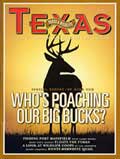
Sore Feet
Don't let blisters ruin an outing.
By Larry D. Hodge
When I was a student athletic trainer at the University of Texas at Austin in the early 1960s, I saw what blisters can do: reduce the biggest, toughest football player on the team to a little boy with tears in his eyes. Two-a-day practices in August heat generated blisters on top of blisters, and we spent a lot of time treating them.
Blisters are bad news. You don't want them, and later I'll point out some ways to prevent them. But blisters arrive quietly in your boots, often before you realize you have a problem. Knowing how to treat blisters in the field can mean the difference between a very painful walk back to camp or a comfortable continuation of your journey.
Friction between foot and footwear is the enemy. Friction generates heat, and forming blisters announce themselves as "hot spots." As soon as you feel a hot spot forming, stop and inspect your feet. If the skin is an angry red but no fluid sac has formed, you may be able to prevent a blister by applying a bandage over the place. If it is tender, fold the bandage in half and cut a half-circle in it to make a "doughnut." Place the hole over the hot spot. An adhesive strip or a piece of moleskin will work, or you can use one of several blister cushions available in the footcare section of your pharmacy. (These products can also be applied before a walk to prevent blisters; some will last for several days.)
If a blister is small and the fluid sac is unbroken, treat it as above. Topping the pad with the hole in it with another bandage will help prevent further irritation.
Large blisters that are unbroken need to be drained. Using a needle or a small pair of scissors sterilized in alcohol, puncture the fluid sac and press it gently to remove the fluid. Leave the layer of skin over the blister intact; this will help protect the area. Wash with soap and water if available, then apply zinc oxide ointment with a doughnut bandage covered by an over-bandage. Change the dressing once a day and leave it off at night to allow the blister to dry.
Seek medical attention if signs of infection develop (swelling, redness, tenderness, pus or fever). Diabetics or people with peripheral vascular disease should always see their doctor if they get blisters due to the risk of serious infection.
As noted, preventing blisters is much preferable to treating them. Prevention begins with your shoes. Shop for walking shoes right after a long walk, when your feet are swollen, and be sure there is half an inch between the end of your big toe and the shoe when you are standing. Good fit at the heel is also important; shoes should not slip on your feet when you walk. Avoid cotton socks, which hold moisture that softens the skin, making it more prone to blister. Choose socks of moisture-wicking fabric that fit your foot closely - no tube socks. Some people find that wearing a thin, moisture-wicking inner sock topped by a padded outer sock works well.
Eddie Day, assistant athletic trainer at the University of Texas at Austin, shares this trick: "Wear two pairs of socks, with the inside socks turned inside out. That way the socks rub each other, not the foot."
Before heading out for a hike, use one of several chafing-prevention agents. These lubricants are sold in stores that carry running gear. If your feet are tender, apply moleskin or blister cushions to probable trouble areas such as the heel and toes. And if your feet become wet from sweat or stream crossings, change into dry socks.
An old saw holds that "an ounce of prevention is worth a pound of cure." I'm pretty sure the writer was nursing a bad case of blisters at the time.

